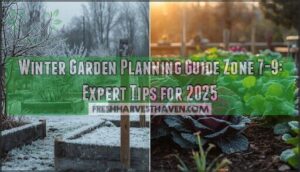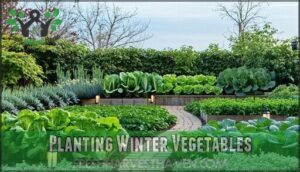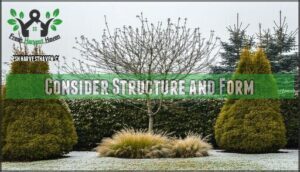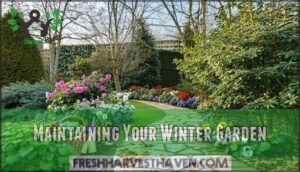This site is supported by our readers. We may earn a commission, at no cost to you, if you purchase through links.
 Your hardiness zone isn’t just a number on a map—it’s the difference between thriving winter color and bare, frozen ground. Zone 7 gardeners watch kale flourish while their Zone 5 neighbors scrape ice off car windows. Zone 9 growers harvest lettuce in January while most of the country hunkers down indoors.
Your hardiness zone isn’t just a number on a map—it’s the difference between thriving winter color and bare, frozen ground. Zone 7 gardeners watch kale flourish while their Zone 5 neighbors scrape ice off car windows. Zone 9 growers harvest lettuce in January while most of the country hunkers down indoors.
Each zone unlocks specific opportunities that disappear just one zone north or south. Understanding your zone’s unique frost patterns and cold tolerance thresholds lets you plant strategically rather than gamble with expensive nursery stock.
The right winter garden planning guide zone approach transforms those dormant months into a season of structure, texture, and unexpected blooms that carry you through to spring’s first warmth.
Table Of Contents
- Key Takeaways
- Winter Garden Planning
- Planting Winter Vegetables
- Selecting Winter Garden Plants
- Designing Your Winter Garden
- Maintaining Your Winter Garden
- Frequently Asked Questions (FAQs)
- . Why Should You Start Seeds indoors?
- . Which Seeds Should You Start indoors?
- . When Should You Start Seeds indoors?
- . When Should You Transplant seedlings?
- When to plant winter garden zone 7?
- What month do you plant a winter garden?
- When to plant a winter garden zone 8?
- When to plant winter vegetables in zone 9?
- How often should I water winter plants?
- What winter fertilizers work best for vegetables?
- Conclusion
Key Takeaways
- Your hardiness zone (7, 8, or 9) determines which plants survive your coldest temperatures and dictates specific planting windows—Zone 7 plants in late August through September, Zone 8 extends through early October, and Zone 9 runs from late August through November for year-round harvests.
- Successful winter gardening requires matching three critical factors: your exact USDA zone’s minimum temperature range, frost-tolerant plant selections (like kale, evergreens, and winter-blooming hellebores), and precise timing based on your local last and first frost dates.
- Winter garden structure relies on evergreen shrubs and trees as visual anchors, supplemented by plants offering multi-season interest through persistent seed heads, colorful winter bark, berries, and ornamental grasses that provide texture when deciduous plants go dormant.
- Protecting your winter garden demands layered strategies including 3-4 inches of mulch for root insulation, breathable frost covers deployed before dusk, deep watering 24 hours before freezes, and reduced watering frequency (every 7-10 days) since cold slows plant growth and evaporation.
Winter Garden Planning
A successful winter garden starts with three key decisions. You need to know your hardiness zone, select plants that can tolerate your coldest temperatures, and time everything around your local frost dates.
These fundamentals will guide every choice you make for the months ahead.
Determining Your Hardiness Zone
Knowing your exact hardiness zone isn’t just helpful—it’s the difference between a thriving winter garden and watching your plants struggle through the cold. The USDA Hardiness Zone map divides gardening regions by average minimum winter temperatures. Zone 7 endures lows from 0°F to 10°F, Zone 8 tolerates 10°F to 20°F, and Zone 9 stays between 20°F to 30°F.
Your hardiness zone—whether Zone 7, 8, or 9—determines which plants survive winter’s coldest temperatures, making it the foundation of successful winter gardening
Find your zone using the interactive zone mapping tool with your zip code. Check for microclimates in your yard that affect frost tolerance and actual hardiness levels.
Choosing The Right Plants
Your zone hardiness determines survival, not just growth. Match plants to your USDA Hardiness Zone rating—Zone 7 manages 0°F to 10°F, Zone 8 tolerates 10°F to 20°F, and Zone 9 survives 20°F to 30°F minimums.
Consider these proven cold-tolerant selections:
- Evergreens: Boxwood thrives in Zones 5–9, while North Pole arborvitae resists winter burn with dark green foliage
- Deciduous options: Red twig dogwood adds bright stem color through Zone 7 winters, and panicle hydrangea flowers reliably to Zone 3
- Microclimate benefits: Ground planting improves frost protection versus containers, and wall proximity boosts plant survival rates
Understanding your hardiness zone map is essential for selecting the right plants. Check cold tolerance ratings, soil preparation needs, and your yard’s microclimate effects before buying.
Understanding Frost Dates
Your planting success hinges on frost dates—the average last spring freeze and first fall frost that define your growing season. In Zone 7, expect your last frost between March 22 and April 3, with the first freeze arriving October 29 to November 15. Zone 8 extends this window, while Zone 9 rarely sees frost at all.
These averages guide your gardening calendar tips, but don’t treat them as guarantees. Local conditions shift dates by weeks, so layer your cold weather strategies with row covers and mulch for freeze damage prevention. Understanding frost date patterns is vital for effective garden planning.
Planting Winter Vegetables
Planting winter vegetables isn’t guesswork when you know your zone. Each zone has specific windows when cool-season crops thrive without frost damage.
Here’s when to plant in zones 7, 8, and 9 for a productive winter harvest.
Zone 7 Planting Schedule
Your Zone 7 winter garden thrives when you work with nature’s rhythm, not against it. Understanding frost dates and USDA Hardiness Zone guidelines transforms your Winter Garden Planning from guesswork into precision. Zone 7 sits in that ideal range where you can push the season longer with smart Frost Protection and proper Soil Preparation techniques.
Your last frost usually arrives around April 15th, giving you confidence to schedule succession plantings. Plant Hardiness charts and Winter Gardening Preparation pay off when you’re harvesting fresh greens while neighbors wait for spring.
- Frost Protection – Deploy row covers when temperatures drop below 28°F to shield tender crops
- Soil Preparation – Mix compost into beds by late January for nutrient-rich planting zones
- Crop Rotation – Rotate vegetable families to different beds, preventing disease buildup
- Winter Pruning – Trim dormant perennials and shrubs before new growth emerges
- Garden Layout – Map sun patterns since winter light angles differ from summer months
Zone 8 Planting Schedule
Five key strategies separate successful Zone 8 winter gardeners from those who struggle with timing and plant selection. Your last frost usually arrives between March 15th and April 1st, while the first frost holds off until mid-November through early December. This extended window transforms Winter Garden Planning into a nearly year-round activity.
Start Soil Preparation in late summer by mixing compost and testing pH levels. Cool-season roots like beets and carrots go in September through October. Hardy greens such as spinach and kale thrive when planted October through November. Brassicas need an earlier start—plant cabbage and Brussels sprouts in August or September.
Your Frost Dates allow February and March plantings of peas and onions. Crop Rotation prevents Plant Diseases, so map where each vegetable family grew last season. Monitor Weather Forecasting closely since microclimates create warmer pockets near south-facing walls. Keep basic Gardening Tools ready for staggered plantings, and follow these Gardening Tips for continuous harvests. Smart Plant Selection matched to your specific zone guarantees fresh vegetables all winter.
Zone 9 Planting Schedule
With your frost-free season stretching 270 to 310 days, Zone 9 offers peerless flexibility for Winter Garden Planning. Plant lettuce, spinach, and kale between October and March for multiple harvests. Cool Season crops like beets and carrots mature in 30 to 80 days when sown October through March.
Your Frost Tolerant Winter Crops thrive with proper Plant Selection—try broccoli, Brussels sprouts, and cabbage for reliable yields.
These Gardening Tips guarantee your Climate Zone Gardening succeeds: start tomatoes and peppers late February through March, and use Plant Hardiness data to time succession plantings every two weeks for continuous harvests.
Selecting Winter Garden Plants
Selecting the right plants makes your winter garden thrive when others fade. You’ll want species that tolerate cold snaps while bringing life to bare landscapes.
Here’s what works best across zones 7-9.
Plants With Multi-Season Interest
Your best garden performers deliver a show that changes with the seasons—not just a one-hit wonder in spring. Ornamental grasses like switchgrass transform from blue-green spring growth to reddish-purple summer panicles, then golden fall foliage and persistent seed heads through winter. Deciduous shrubs like coral bark Japanese maple offer summer leaves, autumn gold, and striking coral-red winter bark.
Smart plant selection focuses on multiple features:
- Foliage color transitions—little bluestem shifts from blue-green to wine-red, finishing with silvery winter seed heads
- Persistent seed structures—black-eyed Susan seed heads support birds while adding architectural winter interest
- Winter berries and bark—crabapples retain cherry-red fruit while crape myrtles reveal exfoliating cinnamon bark
Evergreen Shrubs and Trees
While plants with seasonal charm grab attention, evergreen shrubs and trees provide your winter garden’s backbone. These workhorses anchor your landscape when deciduous plants lose their leaves, delivering structure that holds your garden design together through zone 7, zone 8, and zone 9 winters.
Your evergreen landscaping depends on matching plants to your site conditions. Boxwood tolerates partial shade and responds well to tree pruning techniques that maintain formal shapes. Holly varieties offer glossy foliage and berries—ideal for winter garden planning in all three zones. Juniper’s blue-green needles add texture with minimal shrub care requirements.
Position larger specimens as focal points. They’ll create visual weight during winter planting season, anchoring beds that look bare after frost. Consider rhododendrons for broad leaves and spring flower buds, or select pines for dramatic silhouettes. Proper evergreen shrubs selection transforms your garden from a winter void into a structured, purposeful space.
Winter-Blooming Flowers
When winter chill sets in and most blooms retreat, a handful of resilient flowers step up to paint your garden with unexpected color. These cold-hardy champions deliver winter blooms across zone 7, zone 8, and zone 9, transforming your landscape into living flower arrangements that defy frost dates.
- Hellebores – Christmas roses thrive in shade with minimal petal care
- Camellias – Glossy evergreen foliage frames stunning winter-blooming flowers
- Pansies – Reliable seasonal colors that bounce back after frost
- Cyclamen – Delicate blooms add sophistication to shaded spots
- Witch Hazel – Fragrant ribbons of yellow brighten bare branches
Designing Your Winter Garden
A winter garden isn’t just about what you plant—it’s about how you arrange everything to create a space that looks good and works well even in the cold months. The right design choices help your garden stay interesting when most plants are dormant.
Here’s how to shape your winter landscape so it delivers structure, warmth, and visual appeal all season long.
Consider Structure and Form
Your garden’s bones—the structure you build now—will carry you through the bleakest months when color takes a backseat to form. Think of evergreens as your anchor points. Position them where you need year-round presence.
Multi-stemmed trees reveal their architecture once leaves drop. Layer heights to create depth—tall conifers behind mid-sized shrubs, with ornamental grasses providing textural contrast.
Your spatial planning should emphasize plant texture and form variety that shine under winter’s stark light.
Garden Furnishings and Decor
Once structure sets the stage, the right finishing touches—a weathered bench, a flickering lantern, a stone sculpture—turn your winter garden from functional to unforgettable. Garden lighting extends your time outdoors when daylight fades early. String lights along garden pathways or position solar lanterns near outdoor seating to create warm focal points. Decorative statues and water features add visual anchors that shine when blooms retreat.
Container gardens near entryways bring winter interest closer to your outdoor living and recreation spaces. You’ll enjoy your garden year-round when thoughtful garden design meets practical comfort.
Consider these winter garden essentials:
- Fire pits or chimineas for warmth during crisp evenings
- All-weather furniture positioned to view your best garden architecture and design
- Reflective elements like gazing balls that catch low winter sun
Using Containers and Mulch
Containers and mulch work double duty in winter—they shield your plants from the cold while keeping beds looking sharp when everything else goes quiet. Container gardening lets you move frost-sensitive plants under cover when temperatures drop. Choose pots made from thick ceramic or resin that won’t crack during freeze-thaw cycles. Winter potting works best when you select cold-hardy varieties suited to your zone.
Mulch benefits go beyond aesthetics—proper soil insulation protects roots from temperature swings. Apply a 3-4 inch layer around plantings using organic materials like shredded bark or pine needles.
Master these cold frame techniques for container gardens:
- Group containers together to create shared warmth and wind protection
- Raise pots slightly to prevent waterlogging and root freeze damage
- Refresh mulch monthly as materials compress and lose insulating properties
These gardening tips and strategies guarantee your plant selection and care deliver year-round impact through thoughtful winter garden planning.
Maintaining Your Winter Garden
Your winter garden won’t run itself. The months ahead demand smart pruning choices, frost protection strategies, and creative ways to keep color alive when everything else fades. Here’s what you need to stay on top of through the cold season.
Pruning and Deadheading
Sharp pruners in hand, you’re about to discover the secret that separates a dull winter landscape from one that turns heads all season long. Start with clean pruning tools—disease spreads fast through dirty blades. Focus your cutting techniques on removing dead or damaged growth first, making cuts just above healthy buds.
Deadheading tips are simple: snip spent blooms regularly to trigger fresh flowers. This plant renewal strategy doubles as garden sanitation, keeping your beds tidy while encouraging vigorous growth.
Strategic pruning transforms ordinary plant selection and care into a winter garden planning masterpiece that delivers color when neighbors see only brown.
Protecting Plants From Frost
Pruning sets the stage, but protecting those fresh cuts and tender growth from frost is where your real winter vigilance begins. Cold snaps don’t announce themselves politely—they ambush gardens overnight. That’s why monitoring Freeze Alerts for Zone 7 and tracking your area’s Frost Dates matters as much as any tool in your shed.
Here’s your Frost Protection Methods playbook:
- Drape Winter Covers or frost blankets over vulnerable plants before dusk to trap rising ground warmth
- Layer 3-4 inches of mulch around root zones for effective Soil Insulation using shredded leaves or straw
- Water deeply 24 hours before freezes so moist soil releases stored heat through the night
- Position Cold Frames or windbreaks to shield tender crops from biting winds
Breathable fabrics work better than plastic for Winter Gardening—they prevent moisture buildup while blocking frost.
Providing Winter Interest and Color
Frost protection keeps your plants alive, but a few clever choices will make you actually want to step outside and admire them all winter long. Layer Winter Blooms like camellias and hellebores with Evergreen Shrubs for backbone. Add Berry Plants—winterberry and viburnum—for pops of red and orange. Ornamental grasses provide Seasonal Textures that sway with every breeze.
Smart Winter Garden Planning and Design means mixing heights and textures. Combine Frost Protection with Seasonal Planting and Maintenance to keep displays thriving through cold snaps.
| Winter Interest Category | Top Picks for Zones 7-9 | What They Bring |
|---|---|---|
| Winter Blooming Flowers | Hellebores, Camellias, Pansies | Bold color, fragrance |
| Colorful Foliage | Heuchera, Japanese Forest Grass | Year-round visual punch |
| Structural Elements | Ornamental Grasses, Dogwood | Movement, architectural drama |
Frequently Asked Questions (FAQs)
. Why Should You Start Seeds indoors?
Starting seeds indoors isn’t just smart—it’s life-changing. You’ll extend your growing season by 6-8 weeks, giving crops a head start before the last frost. Indoor lighting and controlled soil temperature boost germination rates dramatically.
Seed starting tips include proper seed selection and sowing depth for your zone.
. Which Seeds Should You Start indoors?
Start tomatoes, peppers, and eggplants indoors—they’re heat-lovers needing six to eight weeks before transplant. Use starter kits for easy germination.
Cool-season crops like lettuce thrive with direct outdoor sowing, perfect for zone gardening tips.
. When Should You Start Seeds indoors?
Timing trumps timing—get your seed starting tips right by counting backward from your first frost date.
Indoor lighting and soil temperature control germination rates, so sow seeds 6-10 weeks early.
Transplant seedlings outdoors once cold climates cooperate.
. When Should You Transplant seedlings?
Wait until soil warms to 60°F and nights stay above 50°F after your last frost date.
Harden off seedlings gradually over 7-10 days by exposing them to outdoor conditions for longer periods each day.
This transplant timing ensures strong root development and prevents cold shock in zones 7-9.
When to plant winter garden zone 7?
Like telegraphing your harvest intentions months ahead, you’ll want to sow your Zone 7 winter garden during late August through September. Plant cool-season crops like leafy greens, root vegetables, and hardy herbs.
Cold frames and proper soil preparation extend your growing season. Frost dates guide winter crop selection, ensuring harvest before hard freezes arrive.
What month do you plant a winter garden?
You’ll plant most winter vegetables between August and October. This seasonal planting window gives cool-season crops time to establish roots before frost dates arrive.
Earlier sowing works for frost-tolerant varieties, while cold frames extend your garden timing into November.
When to plant a winter garden zone 8?
Your window of opportunity opens in late August and closes by early October. Plant cool-season crops like kale, lettuce, and radishes during this period.
These frost-tolerant vegetables thrive in zone 8’s mild winters, providing fresh harvests through spring with proper garden preparation.
When to plant winter vegetables in zone 9?
Zone 9 gardeners can sow winter vegetables from late August through November. Your soil temperature should drop below 85°F before seed sowing begins.
Choose cool-season crops like lettuce, kale, and broccoli that thrive before your first frost date arrives in late December.
How often should I water winter plants?
During the colder months, less is more for watering. Check your soil moisture by testing the top inch—water every 7-10 days when it feels dry.
Winter garden plants need less frequent watering since cooler soil temperature slows growth and reduces evaporation.
What winter fertilizers work best for vegetables?
Your vegetables need balanced, slow-release fertilizers like 10-10-10 during winter months. Organic fertilizers and compost work beautifully as soil amendments.
Feed less often since cold climates slow growth, focusing on vegetable nutrition through winter composting and proper fertilizer timing for healthier seasonal gardening.
Conclusion
The early bird catches the worm, and in winter gardening, timing separates thriving beds from frozen disappointments. Your winter garden planning guide zone strategy determines which vegetables fill your plate in January and which ornamentals anchor your landscape through the coldest months.
Zone 7 gardeners plant kale by September. Zone 8 growers extend their lettuce harvests into December. Zone 9 schedules reveal year-round color most climates can’t touch. Master your zone’s rhythm and you’ll never face another barren winter landscape.
- https://planthardiness.ars.usda.gov
- https://vegplotter.com/blog/planning-your-winter-garden
- https://www.thisoldhouse.com/gardening/100018/understanding-the-plant-hardiness-zone-map
- https://www.motherearthnews.com/organic-gardening/winter-gardening-tips-zm0z13onzsto
- https://yardandgarden.extension.iastate.edu/how-to/winter-garden-tasks









